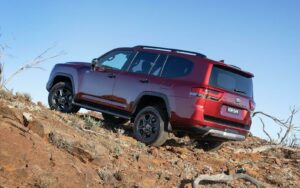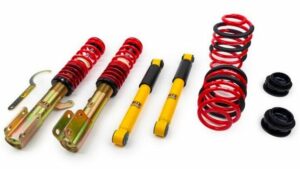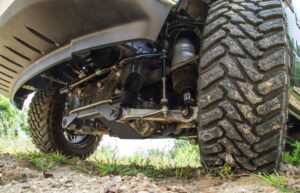Toyota has given the Tundra a significant redesign in 2022. It’s the first time in 14 years that they’re changing the full-size pickup truck. They chose a simple approach: keep what works and improve the bad parts. It feels like a no-brainer, but it’s just a natural evolution of an already great car.
Some of the new features are:
- A new rear suspension.
- A completely new frame.
- An improved and more sophisticated interior design.
- And perhaps the most interesting new addition, a new powertrain.
Toyota tossed the old V8 to now offer two twin-turbo V6 options. The standard is the Turbocharged V6 while the other one is a mighty hybrid. It has an electric motor and battery, and just because it’s electric doesn’t mean it’s less powerful. On the contrary, the hybrid option produces 437 hp and 583 lb-ft of torque against the traditional engine’s 389 hp and 479 lb-ft of torque. Both options feature an automatic transmission that goes up to 10 speeds, opposing the 6 of the old model and a max towing capacity of 12,000 pounds.
Speaking of the new transmission, it’s arguably one of the best features of this new generation. You’ll be shifting quite often, however, each gear flows really nicely into each other. You can downshift several gears at once if you need more power to go up a hill or pull heavy loads.
The new Toyota Tundra will give you an amazing experience when you drive it, whether on roads or in the city, and it’s really decent off-roading too. But if you want to enhance your off-road driving you should consider installing a lift kit.
A lift kit raises the front of your truck by a few inches to give you more ground clearance. It will improve the off-road capabilities of your truck. It also may increase your towing capacity, allowing you to pull heavier loads. If you are new to lifted trucks, here’s what you need to know about them.
Table of Contents
What Is A Lift Kit?
A lift kit is a modification to your vehicle that allows you to raise the front end. It consists of a set of spacers that raise the front of the car. This is accomplished by replacing the coil springs with longer ones. These longer springs allow the truck to sit higher off the ground while still staying somewhat close to the original height. This gives you extra ground clearance, better stability when driving off-road, and allows you to drive over steeper terrains.
What Are The Benefits Of A Lift Kit?
Having more ground clearance will allow you to drive over more rugged terrains. It will also improve the way your trailer looks and give you a smoother ride. It may even allow you to drive at higher speeds on rougher roads without causing damage to your undercarriage or tires.
What Are The Types Of Lift Kits Available?
There are three main types of lift kits available: body lift kits, suspension lift kits, and leveling kits. Each kit comes with its own set of advantages and disadvantages. In general, raising your truck will increase the center of gravity and increase the risk of rollovers. It can also make the truck more difficult to handle at high speeds. On the other hand, raising your truck will make them more suitable for off-road scenarios. This is a game of balancing and finding what is right for your needs.
Here are the main characteristics of each kit.
- Body lift kits: There are front and rear lift kits. They work by elevating the truck’s body by 1 – 5 inches from the frame. This allows for larger tires, but not as much clearance as a suspension kit, that’s because your chassis and suspension levels are not changed. This is mostly a cosmetic change. They are the cheapest alternative and great if you drive mostly on streets and highways, not in particularly rough terrain.
- Suspension lift kits: This is the way to go if you do a lot of off-road driving. They extend the truck’s suspension (or replace it entirely), which in turn, will raise everything else. Now you have enough ground clearance and space for big tires. The days of worrying about damaging the undercarriage are gone. Contrary to body lift kits, you can raise your truck as much as you desire.
- Leveling kits: Leveling kits are a bit unique, they can serve a purely aesthetic purpose or a functional one. They level out the front and the back of the truck, raising the front slightly. Trucks are usually designed to have the front lower. This considers the weight of the engine and the fact that when you load the bed, it will all balance out. Leveling kits are useful if you’re planning to add something heavy to the front, like a plow or a winch. You also get more clearance in the front to add larger tires. Sometimes you might not ever need a leveling kit, all you need is careful planning and crafting when installing a body lift kit. You may also find a hybrid body lift/leveling kit.
What Other Accessories Should You Consider With Your Lift Kit?
The main thing you should consider changing after installing a lift kit is new tires. The extra clearance allows you to get bigger tires, better suited for off-roading and with more traction. Upgrading your suspension and brake systems is also important to handle the increased weight. Lastly, adding a skid plate is always a great idea. If you’re off-roading more, you may damage all the important bits and pieces under your truck. Stuff like the transmission, radiator, and fuel tank.
Are There Any Safety Concerns When Purchasing A Lift Kit?
The most important thing to be aware of when getting a lift kit installed is getting the proper alignment for the wheels and axles. If a lift kit is not properly aligned it can result in poor handling, which can cause accidents both on and off the road.
It is also crucial that the lift kit is installed by an experienced technician who knows how to balance the weight and get everything running smoothly. Generally, most companies that sell lift kits offer some form of warranty. If anything goes wrong with the installation or the truck after the lift kit has been installed, they will cover any repairs that need to be done. You should always do your research before buying a lift kit to make sure that it is high quality and safe to install on your vehicle.
How Much Does It Cost To Lift A Tundra?
The cost of lifting a Tundra depends on many factors. The main reasons are:
- The height you want the truck to be raised to.
- The type of lift kit you choose.
- Whether it is installed by a certified mechanic or not.
On average, you can expect to pay around $1,000 to $4,000 for both the kit and installation. You could also do it yourself, but this should only be an option if you really know what you’re doing. This might end up as one of those situations where you try to save some money and end up paying more than if you went with a professional first.
How Do You Install A Lift Kit On A 2022 Tundra?
Installing a lift kit is a rather simple process if you’re familiar with the basic workings of a car. But even if you’re not that confident in your abilities, there are many resources available online that can help you with the installation. These resources include videos and written tutorials. With a quick search online, you can find information about many different brands of lift kits. Once you have chosen a brand, you will need to buy lift kit components from a physical store or online supplier and install them according to the instructions provided. Nevertheless, if you feel like you need more assistance, you can always contact the manufacturer, a certified mechanic, or even your dealership so they can provide you with more information.
Can You Lift Any Toyota Tundra?
Yes, you can! However, you should be aware of the older models. Technology is always changing and improving. Newer kits might not be a great fit for the early generations. You might have some safety hazards because of part incompatibility.
Is The 2022 Tundra TRD Pro Lifted?
Yes, the 2022 Toyota Tundra TRD Pro comes with a factory lift of 1.1inch on its front suspension. This is the off-road package with several trim levels. It also offers exclusive dampers, all-terrain tires on 18-inch wheels, an off-road driver aid software, lots of safety features, and the powerful i-FORCE MAX 3.5L Twin-Turbo V6 Hybrid.
Does Toyota Make A Lift Kit For The Tundra?
No, but several companies offer lift kits for Toyota trucks. You can find several options online such as Zone Offroad, Rancho, Pro Comp, and many more. As I said before, always do your research and consult a professional mechanic before deciding which one to install.
What Is The Best Lift Kit For The Toyota Tundra?
This depends on several factors. Mainly on how you plan to use the truck and how much money you are willing to spend. Each lift kit has its characteristics and applications. Cheap kits won’t probably offer much elevation and be as reliable. More expensive kits will have a higher lift rate, which will give you more ground clearance and allow for the installation of larger tires, better suited for rugged terrains. Besides the tires, other accessories like bumpers, winches, and racks may be used.
Can You Fit 35-Inch Tires On A 3-Inch Lifted Toyota Tundra?
Yes, you can fit 35s on a 3-in lifted Toyota Tundra, but some trimming will be required depending on the tire tread pattern. You can even fit 35s on a stock Toyota Tundra, although the only way to make it work is by installing a 2-in front leveling kit. Again, trimming will be required to make it work. The best way to fit 35s is with a 5-inch body lift. You should be careful that changing into such a big tire may require you to adapt your driving style.
Will A Leveling Kit Void A Toyota Tundra Warranty?
No, it will not, as long as you get it from a reputable dealer and they did not do anything shady to your factory suspension. It’s always a good practice to call your dealership and go to certified body shops to have the leveling kit installed. If you notice anything different or outside of the expected, contact your dealership as soon as possible.
Can You Tow With A Lifted Toyota Tundra?
Yes, you can. However, lifting your truck affects how it handles the tow. To put it in simple terms: if you get a body lift, your towing capacity will be unchanged. As well as the truck’s payload and gas mileage. The only scenario where towing capacity may be affected is if you have a bumper tow. In this case, a drop hitch is necessary. But if you plan to tow heavy loads, a bumper tow is inadvisable.
On the other hand, in a suspension lift, where the whole truck is elevated, all of those (towing capacity, mileage, and payload) are affected. Again, a drop hitch will be needed to regain towing capacity.
Keep in mind that a longer drop hitch won’t be as stronger and stronger drop hitches can be quite expensive. In general, towing with a suspension lift, though doable, is often not recommended due to the difficulty of getting everything right.
Since larger tires for off-roading are often one of the motivators for lifting a truck, you have to take into consideration that they too affect towing. Your truck’s big tires need to spin at the same rate as the trailer’s smaller tires. As a result, lower RPMs, and lower RPMs means that the truck will tow less. It is wise to get bigger brake pads because the low RPMs require more effort to stop and tires will exert more pressure on the pads. You need your brakes to work for your truck and the trailers, so brakes become even more important in this case.
If you’re wondering if lifting your truck affects the payload, you’ll be pleased to learn that it does. Since there’s more ground clearance and more space to sag, your vehicle will carry more on its bed and drive steadier.




